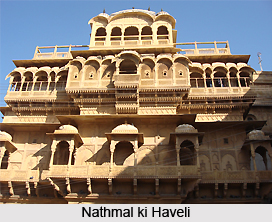 Nathmal ki Haveli is one of the most breathtaking palaces located in the `City of Palaces` named Jaisalmer, in the western Indian state of Rajasthan. It had been constructed with an aim to serve as the residential quarters of the then Prime Minister of India, Diwan Mohata Nathmal and Maharawal Beri Sal had commissioned the erection of the Haveli. It is believed that the two architects of the `Haveli` named Lulu and Hathi were two brothers who were responsible for constructing this magnificent Indian palace. There exists a popular legend associated to the creation of this famous haveli.
Nathmal ki Haveli is one of the most breathtaking palaces located in the `City of Palaces` named Jaisalmer, in the western Indian state of Rajasthan. It had been constructed with an aim to serve as the residential quarters of the then Prime Minister of India, Diwan Mohata Nathmal and Maharawal Beri Sal had commissioned the erection of the Haveli. It is believed that the two architects of the `Haveli` named Lulu and Hathi were two brothers who were responsible for constructing this magnificent Indian palace. There exists a popular legend associated to the creation of this famous haveli.
It is believed that these brothers had begun to build different portions of the Nathmal ki Haveli almost at the very same time, simultaneously. Since there was a lack of proper instruments in the olden days to gauge the continuity of the construction of the palace, the final appearance of this haveli is slightly irregular in shape. While one side of the haveli appears concentrated towards the right, another side of the haveli is concentrated towards the left, thereby creating an ideal symmetrical look.
The architectural marvel of Nathmal ki Haveli has awed innumerable tourists who continue to visit this unique and ancient Indian palace. The interior walls of this haveli possess the images of two elephant which are carved out from yellow stone which are life-size replicas that have been placed in the anterior part of the main entrance of the haveli. One would feel that the statues have been built in a manner as if they are guarding the main entrance gates of the grand palace. Beautiful miniature paintings portraying several species of flora, cattle, horses and others which have been embedded over the walls and pillars of the haveli are an added attraction. However, cars and fans have also been depicted in the inner walls of Nathmal ki Haveli.
Historians believed that the builders who were brothers were completely unaware of these modern amenities and had accomplished the mission of engraving their patterns merely with the aide of the descriptions offered by the people who had observed them. This haveli exhibits a rare form of architecture which bears a sharp contrast to the one noticed in the palatial buildings of other portions of Jaisamer. The architectural characteristics of Nathmal ki Haveli is a combination of Islamic arts and also Rajput style of architecture. Other drawings include those of European style steam engines, bicycles and horse carriages.



















